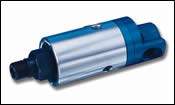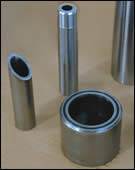Gundrilling On A Machining Center
In many applications, gundrilling does not require specialized equipment. This article explains how gundrilling can be performed effectively on standard vertical or horizontal machining centers.
In many applications, gundrilling can be performed on standard vertical or horizontal machining centers. It does not always require specialized equipment. To perform gundrilling successfully, a standard VMC or HMC must provide sufficient coolant delivery and have sufficient Z-axis travel.
The relatively recent industry-wide standardization of through-spindle coolant allows standard machine tools to drill deep holes effectively in applications that require accurate placement, precise size and improved wall finish. In fact, gundrilling is worth considering any time the tool list specifies an aircraft length or other long-length drill.
Machining centers can accommodate two types of gundrills. The one-piece design is typically found in small-diameter applications of less than 10 mm and is made from a solid carbide blank. It provides superior strength, stiffness and tool life in machining difficult materials. The three-piece design features a brazed construction from a carbide tip, hollow V-shaped tube and shank. It is the oldest and most popular style of gundrill.
The three-piece gundrill’s popularity stems from the fact that it is easy to assemble from modular components, making nearly any diameter between 0.031 inch and 2 inches attainable. Generally speaking, operators are most familiar with the performance characteristics and torque limitations of this type of gundrill.
The relationships between pressure, flow and drilled diameter are critically important when gundrilling because of the inaccessibility of the tip deep within the part and the inability of flood coolant to help flush away chips. As in other applications, coolant reduces the heat-affected zone in the material, cools the tip of the tool and, removes chips from the hole. As the drilled diameter decreases, the required pressure for successful application increases. Coolant pressures can range from 150 psi to 1000 psi. However, as the drilled diameter increases, pressure becomes less important and flow rate becomes the greater concern. The required force to remove chips from inside the hole is based in part on the amount of area in which the coolant has to act. Typical coolant flows can be as little as 1 gallon per minute to as much as 10 gallons per minute.
Auxiliary coolant units are available to help older machines already fitted with through-spindle coolant meet today’s standards in pressure and flow. The positive-displacement type is among the most popular and durable on the market and it can be easily interfaced to virtually all controls. Located on the back of the spindle is a rotary union such as the one pictured above that is manufactured by Deublin Company (Waukegan, Illinois). The rotary union transmits coolant from the pumping system, through the spindle, to the tool. This coupling can be upgraded if necessary to meet new pressure requirements.
Another area of concern is the Z-axis travel limit. Because the tools can be very long, clearing the tool over the workpiece can cause “Z+ over travel” alarms. A good reference point for maximum length is the longest length that can be changed by the automatic tool changer. However, due to the fragility of the gundrill, using the toolchanger is not recommended. These fragile tools are generally hand loaded to prevent damage.
Another machine feature that can help a machining center perform gundrilling is spindle load or tool monitoring. During drilling, the tool tip will not be visible, and the normal visual cues that alert operators to trouble will be absent. The ability of the CNC to monitor torque and force loads is of great value because removing broken drills from workpieces can be a tedious chore, and the control can stop the tool before breakage occurs.
Read Next
Deep Thinking
A job shop that specializes in gundrilling points out the special requirements of machining deep holes.
Read MoreDeep Thinking
A job shop that specializes in gundrilling points out the special requirements of machining deep holes.
Read More







.png;maxWidth=300;quality=90)












